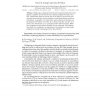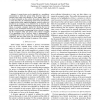528 search results - page 35 / 106 » What Can We Learn Privately |
GECCO
2003
Springer
14 years 27 days ago
2003
Springer
Abstract. Designing an adequate fitness function requiressubstantial knowledge of a problem and of features that indicate progress towards a solution. Coevolution takes the human ...
AIED
2007
Springer
14 years 1 months ago
2007
Springer
This paper demonstrates how stereotypic student groups can be created to enhance cognitive models in computer tutors. Computer tutors use cognitive models to track what skills stud...
ICMCS
2007
IEEE
14 years 2 months ago
2007
IEEE
— A smart house can be regarded as a surveillance environment in which the person being observed carries out activities that range from intimate to more public. What can be obser...
INFOCOM
2009
IEEE
14 years 2 months ago
2009
IEEE
Abstract—New modes of communication have shown themselves to be needed for more secure and private types of data. Steganography or data-hiding through covert channels can be high...
CRYPTO
2008
Springer
13 years 9 months ago
2008
Springer
In cryptography, there has been tremendous success in building various two-party protocols with small communication complexity out of homomorphic semantically-secure encryption sc...


